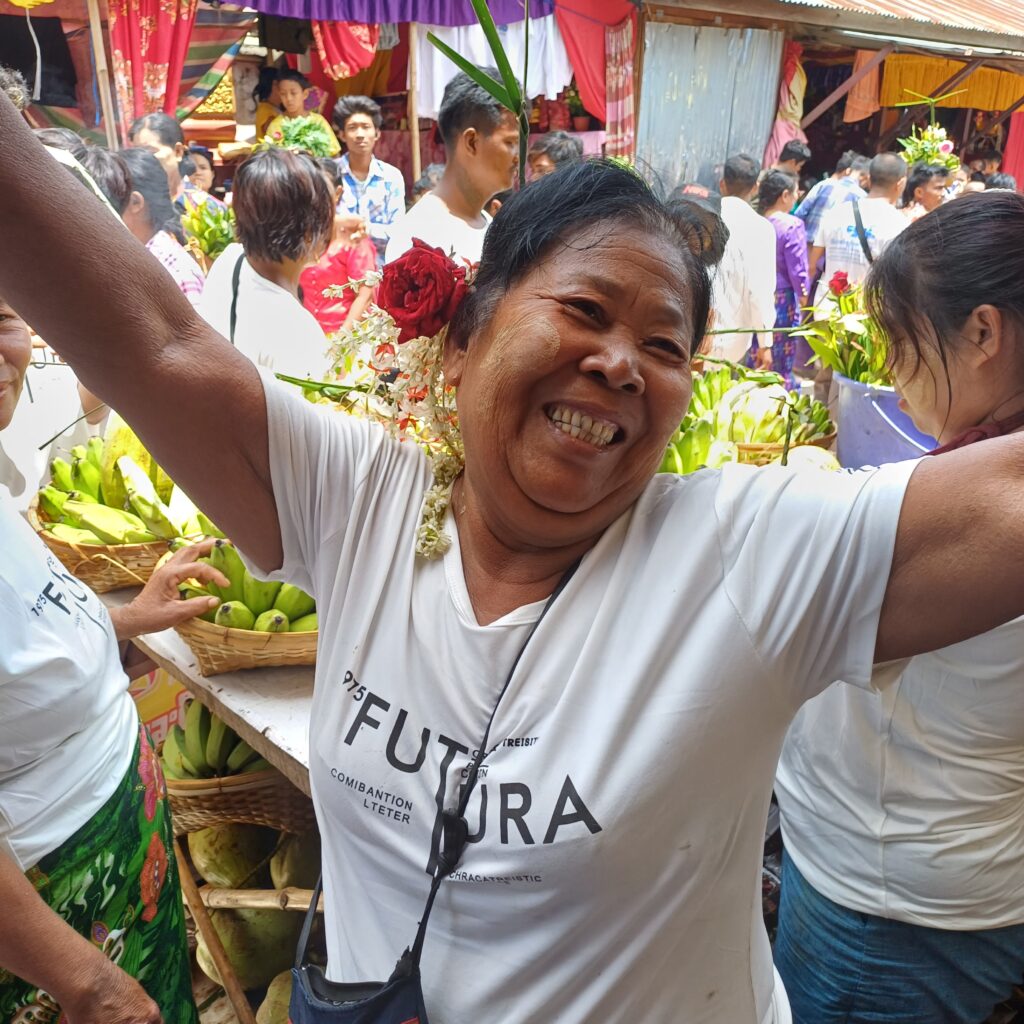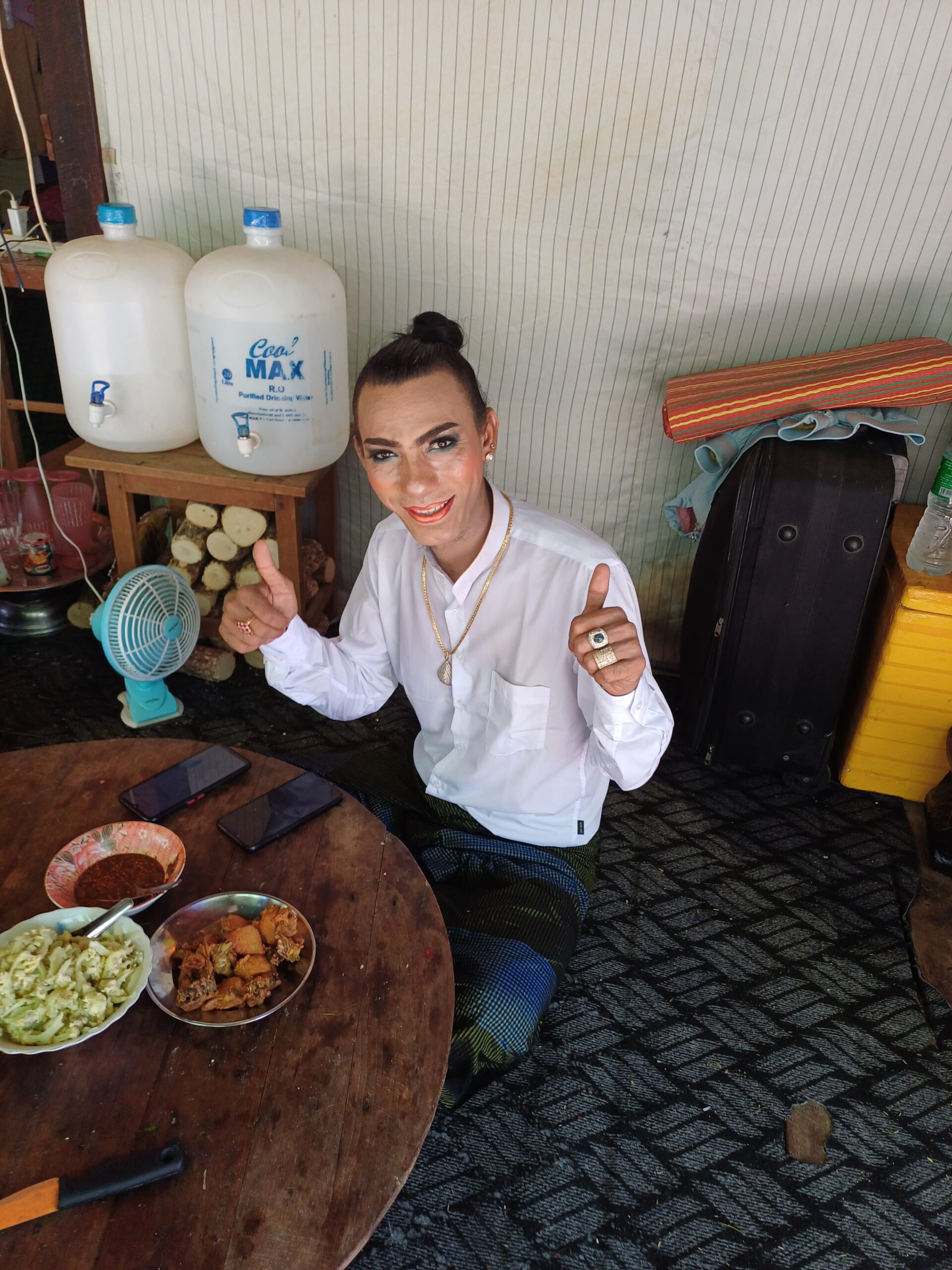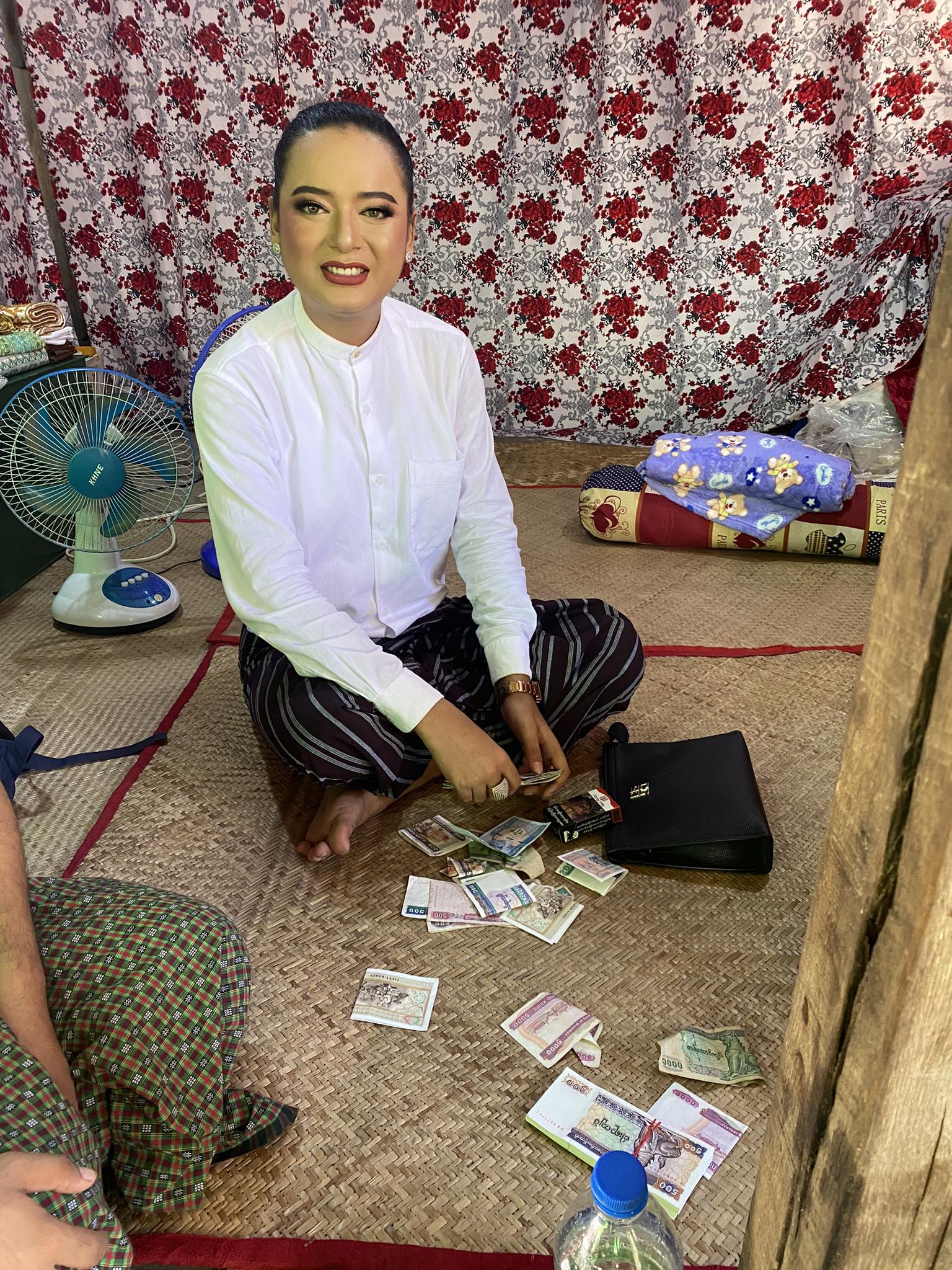The Taungbyone Nat Pwè in Myanmar

Taungbyone is a village in Upper Myanmar, located around 50 km north of Mandalay. It is the venue of the country’s biggest and most important spirit festival (nat pwé). As most of the other important nat festivals it takes place during the rainy season which marks it as a distinctively non-Buddhist affair because in the Buddhist lent (rainy season) all festive activities are forbidden. Regarding the myths surrounding this festival pls. see at the end of this article.
The festival It is like a review of the natkadaw, the mediums of the cult of the nat. Literally it means ’spirit’s spouse‘. Nowadays, most of them are homosexuals, even though traditionally there were many women pursuing this profession. When I asked one of my friends, who is a natkadaw, why there were so many homosexuals among them, he gave me a very lucid explanation. He said that they could impersonate female as well as male nats. It would inappropriate for a woman to impersonate a male nat.
The nats that are worshipped in Taungbyone are the so-called Taungbyone brothers. They were the sons of a the Popa Maedaw and the Muslim nat Byatta. The latter was killed by king Anawrahta for neglecting his duty. His wife died of grief thereafter. The king then adopted their two sons who were called Shwepyingyi und Shwegyinnge. When they grew up they proved themselves to be worthy military commanders. Later they shared the destiny of their father and were killed on the king’s command. Some say that the king’s order had been misinterpreted, others don’t.
The two brothers ‚rule‘ over a great expanse, particularly the Ayeyarwady River. When I worked as a tour leader I very often did a trip down that river (from Mandalay to Bagan) with my clients. It took around 10 hours, we started at sunrise and arrived at sunset. Of course we had to cater for the clients‘ lunch which we ordered in a local restaurant. When the food was brought aboard the crew nearly fainted: the ignorant foreigners had ordered pork! An unforgivable blasphemy as the brothers were Muslims. So we had to leave the pork dish behind at gave it to the children at the jetty. I guess it must have been a feast for them.
Find more about the fascinating world of Myanmar’s peoples belief in spirits HERE:





Superstitions and traditions around the festival (by Harry Hpone Thant)
The Taungbyone Nat Festival was originally a pagoda festival for the Su Taung Pyae Pagoda on the full moon day of the Burmese month of Wagaung (August/September) at Taungbyone village in Upper Myanmar. But somehow, the nat festival eclipsed the pagoda festival. Going back in time, this pagoda was said to have been built at the time of King Anawrahta (1014-1077) of the Bagan Dynasty. On his return from a military expedition to China he pitched camp there. To commemorate his campaign he decided to construct a pagoda there. He decreed that everyone of his retinue was to contribute one brick towards its construction.
Among his entourage were two twin brothers, Shwebyin Gyi and Shwebyin Galay. They had been adopted by the king and enjoyed his special affection. Overestimating their status at the court they did not heed the king’s command, but spent their time drinking toddy palm juice and at cockfights and womanising instead. That way they simply forgot to contribute their share of one brick towards the construction of the pagoda. At the completion of the construction, the King came to inspect the building site and saw the two vacant spaces on the wall of the pagoda. He asked who the culprits were and the answer was: “Your favourite grandsons, the Shwebyin brothers“. The king was outraged and ordered that the two were to be punished by flogging with stalks of reeds. In fact, he had a gentle slap on his mind. But those among the courtiers who hated the brothers took the king’s command literally and had them beaten to death with bamboo sticks and then drowned them.
When time came to depart for Bagan, Anawrahta’s royal barge was stuck. The two brothers appeared as nats and told him their sad story. They were given a royal pardon and granted patronage over Taungbyone village. And the Taungbyone Nat Festival was born!
I had never been to that festival. Mom was afraid these nats would take away the butterfly spirit of her only son and prohibited me from visiting the festival and she herself also refrained from going there. I was able to see this Taungbyone village only around 2002. We were driving back from Mogok and one of us had this idea to detour to see the Sit Htwet Pwé at Taungbyone village. I think it was in March. Legend has it that Anawrahta started his campaign to China from here and it was to commemorate this event. Sit Htwet means ’starting the military campaign’.
We were fortunate to see the ritual of sending Anawrahta’s army on its journey and saying farewell to the two Shwebyin brothers who would accompany the troops. These rituals were performed by the traditional ‘Nan Htaings’ ( hereditary custodians of the nat pavilion). It was not so popular with the general public, in no way comparable to the Wagaung nat festival. Only some die hard nat-votaries, i.e mostly nat mediums (nat kadaw in Myanmar) were there.
I also saw the legendary two vacant spaces on the wall on the Su Taung Pyae Pagoda and learnt about the various taboos and superstitions connected with the Taungbyone Nat Festival.
The Lun Taung (asking for rope) villagers are prohibited from coming to the Festival, As I’ve learnt, Lun (လွန်)is another word for thick rope in the Myanmar language. When the two brothers were captured, the captors asked for ropes to tie the prisoners. The village complied and subsequently the villagers were banned from visiting the festival as punishment! Another superstition was that on the specific day of the nat festival, people from nearby villages had to bring toddy palm wine and barbecued rabbit to the festival. The idea behind it is that, as the two brothers were notorious as binge drinkers of toddy wine they must be hosted with their favourite drink and food. This day is the most rowdy day of the festival. Most visitors are drunk. Abusive and rude words towards the womenfolk are hurled indiscriminately. But nobody takes offence, even the victims. The rationale is, as the two brothers were rowdies and binge drinkers in life, they must be appeased the way in their other life too.
Waryin Doke village (ဝါးရင်းတုတ် )is where the villagers gave the bamboo staffs to beat the brothers. The villagers here were sanctioned too. Not sure, but their punishment was to clean up the venue after the festival (?) Htain Khote day (ထိန်ခုတ်ပွဲနေ့) is another important day in the festival calendar. King Anawrahta was supposedly killed by the malevolent ထိန်ပင်စောင့်နတ် Htainbin Saunt Nat ( a nat who lives in a htain tree) as he entered Bagan. In revenge, small branches of the tree are symbolically cut down in front of the main pavilion where the statues of the brothers are kept. These and other superstitions and traditions are widespread all over the villages in the area.
But in essence, this is a pagoda festival. As usual, on the Full Moon Day of August (Wagaung), the ritual donation of victuals for the monks concludes the Festival.





